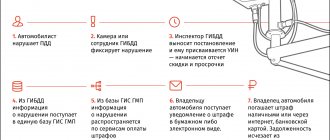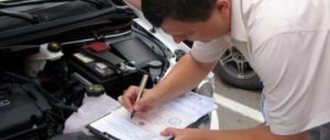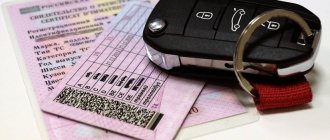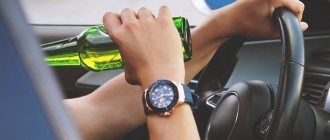Many accidents and injuries occur due to drivers not giving way in designated areas. Moreover, the fine “failure to give way” is a minor punishment, rather a preventive one. After all, everyone must yield to pedestrians at crosswalks and to vehicles if there are signs or an advantage.
An administrative penalty may be imposed if:
- do not give way to special vehicles;
- to another vehicle;
- pedestrian or cyclist.
The most unpleasant situation for the driver is the so-called “chain letters”, when photo recording has registered a violation. In order not to wait for a letter with the administrative protocol, it is best to install SMS notifications about fines in your mobile banking application. Then, if you agree with the offense, you can pay the fine with a bank card using a few keystrokes. This will allow you to avoid the accrual of penalties and quickly find out about the existence of an administrative protocol. It will be easier to challenge it if it was issued unfairly.
Failure to give way to a pedestrian/cyclist
The fine when the right of way was not given to a pedestrian or cyclist is higher. It is 1500 rub.
Many legislators believe that it should be significantly increased.
This is possible in the near future, since there are too many cases of fatal injuries to citizens right at a pedestrian crossing. Therefore, you should not so much be afraid of fines as remember the possible consequences of incorrect driving.
How to give way and not violate anything?
It very often happens that the provision of privileges by the driver for a special vehicle led to violations of traffic rules (for example, hitting another car, overtaking or driving onto a solid marking line).
When you see special vehicles, you must behave as follows:
- stop and let the special vehicle pass;
- if the car is stationary, do not start driving until the car with special signs has passed;
- if there is a need to change lanes to clear the way, then the action must be carried out in accordance with the traffic rules.
Sometimes you can fall into the trap of traffic police officers who like to catch offenders at intersections or provoke overtaking. It’s not always possible to figure things out in time when you’re in a lot of traffic. Most accidents occur due to ignorance on the part of the driver, who vacated the lane and interfered with other participants. In this case, special vehicles will not be held liable, since hasty or careless provision of an advantage is solely the fault of the driver.
If a violation committed during the provision of priority to special vehicles is recorded by video recording, you need to send a complaint to the video recording center of the Central Internal Affairs Directorate, in which you justify the reasons for the violation.
Alas, even the courts rarely take the side of drivers who violate traffic rules in order to allow an ambulance to pass. The practice in this part is very sad.
Did not give way to special vehicles
If a vehicle is moving with flashing lights and special inscriptions on, it must give way. The siren, beacons, etc. are on. - this is what the requirement to give way means. Most often (if it is not a police or traffic police vehicle), special vehicles (ambulances, fire trucks) have to additionally honk and make their way through.
This should not happen, but fining everyone on the road at this time is not fair. Therefore, ambulances, fire engines and other emergency vehicles arrive at the scene late due to the fault of drivers who do not respect the rules.
And the driver, who clearly did not give way to special vehicles, pays only 500 rubles. fine _ Or may be of the right to drive for 1 to 3 months
Accident is the daughter of a flasher
The court explained these simple truths to drivers. And not even the first instance. The case of hitting a pedestrian reached the Second Court of Cassation. The driver categorically did not agree that he was guilty of hitting a pedestrian and causing minor harm to his health. After all, a blue light was shining on his car, which means the pedestrian is to blame.
But the courts of all levels thought differently. So, the accident happened back in October last year. Driver Shchetinin, driving an ambulance with the blue light on, drove into a pedestrian crossing at a red traffic light and hit a 16-year-old girl. The girl was crossing the road at a pedestrian crossing at a green signal for pedestrians. She was in a hurry, but did not break the rules.
A light blow from the Gazelle cut the girl's eyebrow and threw her onto the asphalt. Blood covered her face, but she did not lose consciousness. She got up and ran to her entrance, which is located 20 meters from the scene of the incident. Her mother was already waiting for her there, having seen everything that was happening through the window. She treated her daughter's wound and took her by taxi to the emergency room.
And the ambulance driver and the resuscitator, judging by their testimony, lost the girl. They didn't notice her. A silhouette flashed, but they did not feel the blow. The driver stopped the car just in case. They walked around for ten minutes, and then, without calling the traffic police, they left for the substation. They initially returned to it. Therefore, they did not need to turn on special signals.
The driver did not agree that he was guilty of hitting a pedestrian. After all, he had a blue light on his car, which means the pedestrian is to blame
The ambulance driver was not performing an urgent official task - this is stated in all decisions of all courts. That is, this fact was established by the first instance.
The fact that the driver and the doctor did not see the pedestrian, and also did not notice any traces of the accident, became the reason for appealing this first decision. Like, there was no accident.
You can turn on special signals only when performing an urgent official task. Photo: RIA Novosti
However, the emergency room informed the traffic police that a girl injured in the collision had been brought to them. It was not difficult for the traffic police to find both the ambulance and the driver. Video recording of the incident from a city outdoor video surveillance camera installed at the entrance was added to the case. It clearly shows the collision itself, as well as how the ambulance stopped, how the driver and doctor got out, how they stood still and later drove away.
When considering the case, the courts of both the first and appellate instances, and then the second cassation court, recalled that in accordance with the Rules, road users must act in such a way as not to create a danger to traffic and not cause harm.
Paragraphs 3.1, 6.13 of the Traffic Rules establish that drivers of vehicles with a blue flashing light on, when performing an urgent official task, may deviate from the requirements of certain sections, provided that traffic safety is ensured.
To gain an advantage over other road users, drivers of such vehicles must turn on a blue flashing light and a special sound signal. They can take advantage of priority only by making sure that they are given way, the court noted.
Drivers of cars with special signals can take advantage of priority only after making sure that they are given way, the court noted
The evidence collected in the case objectively indicates that the accident occurred as a result of the actions of the driver Shchetinin, who violated precisely paragraphs 3.1 and 6.13 of the Rules. The courts came to the correct conclusion that the harm to the victim’s health is in a direct cause-and-effect relationship with the actions of the driver. Therefore, he was justifiably brought to justice under Part 1 of Article 12.24 of the Code of Administrative Offences. This article provides for a fine of 2.5 to 5 thousand rubles or deprivation of rights for 1-1.5 years. When choosing a sentence of deprivation of rights for a year, the courts took into account aggravating and mitigating circumstances. Moreover, the driver has already been brought to justice several times for violating the rules.
In general, the judge of the Second Court of Cassation upheld the decisions of the lower courts, and the driver’s complaint was not satisfied. But at the same time I once again reminded that a flashing light is only a way to attract attention. And the driver has the right to deviate from the rules, even with special signals turned on, only if others give way and these actions will be safe for others. And, of course, you can turn on the beacon only when performing an urgent official task.
Amount of fine
Obstructing the movement of cars and other road users is a very serious offense that has many nuances. And first of all, what the fine will be is influenced by the road user whom the driver did not let pass. There are different fines for obstructing traffic:
- An ordinary car;
- Cyclist;
- Pedestrian;
- Special transport.
Let's look at them all.
Didn't give in to the car
The most common case is when two cars cannot pass each other on the road. In this case, you can receive one of two fines:
- If you do not let a car pass at an intersection, the fine will be 1,000 rubles. At the same time, the one you didn’t let through should have the right of way on the road. Part two of Article 12.13 of the Code of Administrative Offenses of the Russian Federation is responsible for the fine;
- If you do not allow a car to pass on the highway while performing a maneuver, the fine will be 500 rubles. However, the circumstances of such a violation vary, and in some cases, instead of a fine, a warning is issued or the violation is completely ignored. Part three of Article 114 of the Code of Administrative Offenses of the Russian Federation is responsible for the fine;
Cyclist or pedestrian
The current standards do not distinguish between a pedestrian and a cyclist crossing the road in designated places, although cyclists are given the opportunity to move along special paths. If a pedestrian or driver had the right of passage and crossed the road at the designated place, the fine will be 1,500 rubles. In this case, the circumstances are not taken into account - a fine is issued in any case. The fine is subject to Article 12.18 of the Code of Administrative Offenses of the Russian Federation;
Special transport
The most serious violation associated with obstructing traffic is if the driver does not give way to special vehicles. It does not matter where and how you are driving - if the special transport of the special services makes it clear that it is necessary to clear the road, then you need to obey and move to the side.
The punishment, as in the case of obstructing the movement of an ordinary car, depends on the circumstances:
- If you did not allow a special services vehicle to pass with its audio and light signals turned on, the fine will be only 500 rubles. But, depending on the circumstances, you may also be deprived of your rights for three months or other penalties may be applied;
- If you did not miss a special vehicle that did not have special markings other than audio or light signals, then the fine will be 500 rubles . In addition, in some cases the driver may simply be released after a warning;
- If you do not allow public transport to pass along a specially designated line, the fine will be 1,000 rubles. And if you do this in Moscow or St. Petersburg, the fine will be 3,000 rubles.
Attention
All these penalties are covered by one article 12.17 of the Code of Administrative Offenses of the Russian Federation “Failure to provide priority in traffic to a route vehicle or a vehicle with special light and sound signals turned on.”
When a driver is obliged to let a car with a special signal pass
The traffic rules specify the procedure and list of vehicles that must give way.
The following have priority right of movement:
- police and traffic police;
- ambulance;
- fire service, Ministry of Emergency Situations;
- transport of government bodies.
To indicate their advantage, these machines are allowed to use special signals:
- red and blue are used by the traffic police;
- The blue signal is used on police vehicles, the Investigative Committee, the FSB, ambulance, military police, and the fire service;
- The blue flashing light usually flashes on vehicles used to transport the highest echelons of government.
If the specified special equipment is driving without identification signals and special signs, then they do not have the right to demand that other road users give way to them.
In addition, vehicles carrying out road work or transporting dangerous goods are often found on the roads. Such cars do not enjoy advantage on the roads. In their work, they use special yellow or orange beacons; such signals simply warn oncoming traffic so that the driver is extremely attentive and careful.
During repair work, temporary road signs are usually installed to indicate a safe detour to the road. You must follow the signs strictly.
What does it mean to “give way” and how to do it
The concept of “give way” is spelled out in the traffic rules in general terms:
“Give way (do not interfere)” is a requirement that means that a road user must not start, resume or continue moving, or carry out any maneuver if this may force other road users who have priority over him to change direction. movement or speed."
There is quite a lot of discussion and debate on the Internet about this definition, but in fact the essence is this: you must move the car out of the way of the flashing lights or simply do nothing
, for example, stand calmly on the side of the road as you stood, or continue driving in your lane.
Sometimes difficulties arise. For example, you are stuck in a traffic jam in the left lane and suddenly a car with flashing lights and a siren materializes from behind. In this case, turn on the right turn signal and most likely they will let you into the right lane and you will “give way.”
If the traffic jam is such that there is nowhere to “plug in”, then it’s good to have a video recorder to record everything in detail. If you are suddenly “caught,” the recording will help prove that you were physically unable to take your car anywhere and in fact did not violate anything.
Unfortunately, each case of “not providing an advantage” in a specific traffic situation is unique and general recommendations cannot be given.










